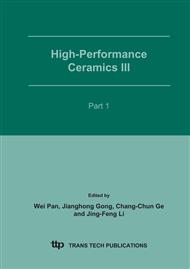[1]
O. Knotek and A. Barimassi: Thin Solid Films Vol. 174 (1989), p.51.
Google Scholar
[2]
L. Rebouta, F. Vaz, M. Andritschky and M. F. daSilva: Surf. Coat. Technol. Vol. 76 (1995), p.70.
Google Scholar
[3]
I. Sakamoto, S. Maruno and P. Jim: Thin Solid Films Vol. 228 (1993), p.169.
Google Scholar
[4]
O. Knotek, M. Bohmer and T. Leyendecker: J. Vac. Sci. Technol. Vol. A4 (1986), p.2695.
Google Scholar
[5]
D. -Y. Wang, C. -L. Chang, C. -H. Hsu and H. -N. Lin: Surf. Coat. Technol., Vol. 130 (2000), p.64.
Google Scholar
[6]
H. Loffler, H.P. Lorenz and D. Schack: Surf. Coat. Technol. Vol. 54 -55 (1992), p.148.
Google Scholar
[7]
L. A. Donohue, J. Cawley and J. S. Brooks: Surf. Coat. Technol. Vol. 72 (1995), p.128.
Google Scholar
[8]
O. Knotek, H. Loffler and G. Kramer: Surf. Coat. Technol. Vol. 54 -55 (1992), p.241.
Google Scholar
[9]
J. Musil, I. Stepanek, J. Musil, Jr. et al: Mater. Sci. Eng. A Vol. 163 (1993), p.211.
Google Scholar
[10]
I. Grimberg, V. Zhitomirsky, R. Boxman, et al.: Surf. Coat. Technol. Vol. 108-109 (1998), p.154.
Google Scholar
[11]
Z. Tonghe, W. Yuguang, Z. Zhiyong and D. Zhiwei: Surf. Coat. Technol. Vol. 131 (2000), p.326.
Google Scholar
[12]
P. Hones, C. Akis, P. E. Shmid, F. Levy and O. R. Shojael: Appl. Phys. Lett. Vol. 76 (2000) p.326.
Google Scholar
[13]
D.Y. Wang, C.L. Chang, C.H. Hsu, H.L. Lin: Surf. Coat. Technol. Vol. 130 (2000), p.64.
Google Scholar
[14]
T. B. Ryer: Electron Diffraction, Bulter and Tanner, London, 1970, p.75.
Google Scholar
[15]
L. Rebouta, F. Vaz, M. Andritschky, M. F. da Silva: Surf. Coat. Technol. Vol. 76-77 (1995), p.70.
Google Scholar
[16]
C. P. Constable, J. Yarwood and W. -D. Munz: Surf. Coat. Technol. Vol. 116-119 (1999), p.155.
Google Scholar
[17]
B. D. Cullity: Elements of X-Ray Diffraction, Addison-Wesley, Reading, MA, 1978. Fig. 5. Variation of the hardness of the Ti-Zr-N film with the substrate temperature.
Google Scholar


